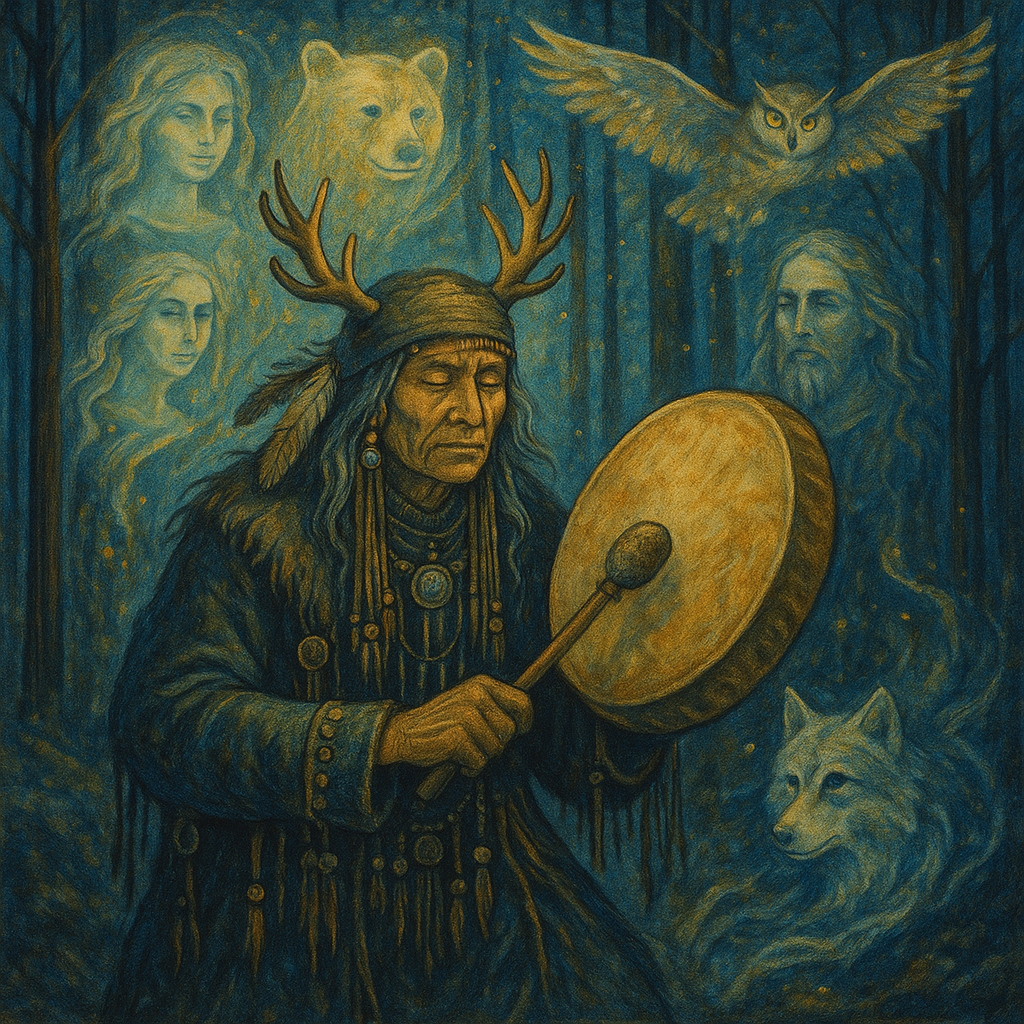Siberian Shamanism: Spirit Communication, Mediumship, and Spiritual Dimensions
Introduction
Siberia, stretching across the vast northern landscapes of Russia and Central Asia, is home to some of the oldest and most influential shamanic traditions in the world. For the indigenous peoples of Siberia, the shaman (kam or noaidi) is the central figure of spiritual life, serving as a medium between humans, spirits, and deities. Through trance, drumming, and visionary journeys, shamans maintain dialogue across multiple dimensions, ensuring health, balance, and harmony for their communities.
Cosmology: A Multilayered Universe
Siberian cosmology describes the world as structured into three interwoven realms:
Upper World: The domain of celestial beings, sky gods, and luminous ancestral spirits.
Middle World: The human realm, shared with animals, plants, and land spirits.
Lower World: The underworld, home to the dead, chthonic deities, and powerful spirits that could harm or heal.
The shaman’s role is to travel between these realms, bringing back knowledge, healing, or guidance for the living.
The Role of Shamans as Mediums
1. Trance and Spirit Possession
Shamans entered trance through drumming, chanting, or dance, often aided by ritual costumes and masks.
Spirits could possess the shaman, speaking through them with otherworldly voices to deliver guidance.
2. Visionary Journeys
The drum was considered the shaman’s “horse” or “reindeer”, transporting them to spirit realms.
Shamans journeyed to the Upper World for wisdom or descended to the Lower World to recover lost souls or battle hostile beings.
3. Healing and Soul Retrieval
Illness was seen as a loss or capture of the soul by spirits.
Shamans communicated with spirits to retrieve lost souls, restore balance, and remove curses.
Ancestors and Spirit Communication
Ancestor veneration was central: the dead remained part of the community, offering guidance and protection when honored.
Neglected ancestors could return as restless spirits, causing illness or misfortune.
Shamans acted as mediums between the living and the ancestral dead, performing rituals at burial sites, hearths, or sacred groves.
Spiritual Beings of Siberia
Sky Gods (Tengri-like figures): Celestial deities who maintained cosmic balance.
Mother Earth Spirits: Fertility and nature deities embodied in rivers, forests, and mountains.
Animal Spirits: Bears, reindeer, wolves, and birds acted as guides and protectors, accompanying shamans in journeys.
Ancestor Spirits: Guardians of families and clans, contacted in ritual.
Malevolent Spirits: Dangerous beings that caused sickness, misfortune, or possession, requiring exorcism by shamans.
Ritual Practices of Spirit Contact
Drumming and Chanting: Rhythms induced altered states for spirit journeys.
Costumes and Masks: Decorated with feathers, bones, and antlers, symbolizing transformation into spirit beings.
Offerings: Food, drink, and animal sacrifices given to spirits, ancestors, and deities.
Fire Rituals: Flames carried prayers to the Upper World, serving as communication with celestial beings.
Dreams and Oracles: Dreams, visions, and omens were interpreted as spirit messages.
Comparisons with Western Mediumship
Similarities: Trance states, spirit possession, ancestor communication, and healing through spirit dialogue.
Differences: Siberian shamanism is tribal, ecological, and communal, emphasizing soul journeys, nature balance, and cosmic order rather than private séances or survival proof.
Continuity and Legacy
Despite centuries of suppression under Tsarist, Soviet, and religious authorities, Siberian shamanism survives:
Indigenous groups such as the Yakut, Evenki, and Buryat maintain shamanic rituals.
Shamans continue to perform healing, ancestor veneration, and spirit journeys in Siberian communities.
Neo-shamanic revivals worldwide often draw heavily from Siberian traditions of drumming and soul retrieval.
Conclusion
Siberian shamanism embodies one of humanity’s most ancient systems of spirit communication, mediumship, and multidimensional cosmology. Through trance possession, visionary journeys, ancestor veneration, and nature rituals, shamans sustain a dialogue across realms, maintaining balance between humans, spirits, and the cosmos.
Unlike Western Spiritualism, Siberian traditions emphasize soul healing, ecological harmony, and communal survival, embedding spirit communication into the very essence of life in the northern landscapes.

